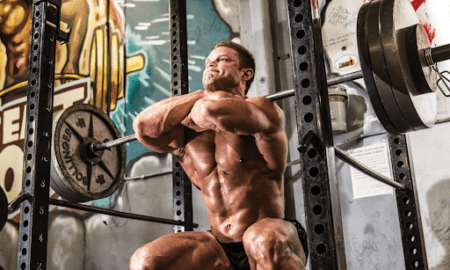Q: You recently wrote briefly about how tall bodybuilders should approach weight training. Could you please tell us more?
A: Almost anyone over 6’ knows that he has at least a few obstacles to becoming a successful bodybuilder. Unless you’re gifted with the right joints and full muscles, you probably have trouble doing bench presses, squats and other multijoint pressing movements. The good news, as most of you know, is that the longer the limb, the more leverage you have for pulling exercises. But what do you do about pressing-type movements?
Let’s start with legs. I’m 6’1”, and legs were a problem for me from the start. I had to come up with all kinds of ideas for squatting heavy enough to grow. I think knee wraps are a must if you have long legs and a big torso—especially if you have small knees. I wear them only on my heaviest sets, not the first few, but when it gets heavy, those wraps go on tight.
Wear a pair of high-top work boots or buy a pair of high-top Olympic shoes. They support your ankles, which are often the weakest link in a long body. Arnold always said that when he did squats, his body leaned forward. When I heard him say that in 1974, I had what I thought was an epiphany—it helped me prevent my body from leaning forward when doing heavy squats. I bought a triple-thick, double-tang weight training/powerlifting belt and pulled it tight around my waist. Then I took my other regular training belt and put it on backward, just above the power belt. (Note: You need someone to help you do that.) It prevents your torso from going too far forward when you do heavy squats.
That still wasn’t enough for me. My ankles felt as if they were moving around inside the boots. So I bought Velcro-strapped ankle socks that stretch and fit really snugly. They held my ankles and upper calves tight. Putting on the socks and shoes and the two belts, plus the knee wraps, may have made me look like a walking mummy, but I could go with 405 for 12 reps without a problem. Before that, I could do only 315 for 12.
Let’s go to chest: I always had trouble with my upper pectorals—I tend toward big triceps and weak upper pecs. Three major things changed that for me: First, I started doing mostly decline pressing. Because my body was inverted, the range of motion was slightly reduced, and I was able to use heavy weight. Second, since my deltoids were lower than my pectorals, my body had no chance to engage the upper deltoids when I pressed the bar or dumbbells upward, which had always happened on my incline-bench presses. Third, when I did incline dumbbell presses, I always pumped up my biceps and forearms first. The amount of blood it puts in the biceps and forearms gives you a considerable cushion as the dumbbells make their way back down and up again. That way you feel stronger and more in control.
How about shoulders? It’s a different muscle group, but basically the same rule applies: Pump up your biceps and forearms before doing presses, and you’ll feel more in control. (When I say pump up, I mean just that. Don’t work the biceps and forearms hard; just pump them up as fast as you can.) Be sure that the pressing bench is positioned so that your feet are flat on the ground and your thighs are parallel to it. For shoulders, the pressing action need be no more than five inches or so. If you’re going all the way up and all the way down, you’re working other muscles, not just the middle head of the deltoid.
The best thing tall people or those who have long limbs can do is try to shorten strokes and strengthen areas where they may be weak. I have seen many guys use some type of elastic band around their triceps—Yates did it, for instance. That joint probably wasn’t as receptive to heavy training as his other joints were. Think of it as the three S’s: shorten, strengthen and wear tight stretchy bands or wraps around joints that are a weak link in any multijoint exercise.
If you have questions, please contact me. I answer all my e-mail.
Editor’s note: Contact Paul Burke via e-mail at [email protected]. Burke has a master’s degree in integrated studies from Cambridge College in Cambridge, Massachusetts. He’s been a champion bodybuilder and arm wrestler, and he’s considered a leader in the field of over-40 fitness training. You can purchase his book, Burke’s Law—a New Fitness Paradigm for the Mature Male, from Home Gym Warehouse. Call (800) 447-0008, or visit www.Home-Gym.com. His training DVD “Burke’s Law” is also now available.




















You must be logged in to post a comment Login